Meet the 10 emerging fashion designers bringing innovation to Milano Fashion Week



Istituto Marangoni Milano’s top emerging designers reinterpret history and push boundaries at the XC | 90 graduate show during MFW 2025
What defines the future of fashion? This question drove the ten graduate collections from Istituto Marangoni Milano’s most promising emerging fashion designers, who took to the runway on 27 September at the enchanting Galleria Meravigli during Milano Fashion Week, as part of the XC | 90 show, which celebrated the school’s 90th anniversary. Each designer translated their unique vision into a concept that combined fashion inspiration, creative storytelling, and a personal interpretation of contemporary style, resulting in captivating displays.
Emerging Designers: Blending Historical Inspiration and Modern Creativity
In a world where young creatives often look to social media icons for guidance, many of these up-and-coming fashion designers found inspiration in the past. References ranged from 1950s advertising campaigns to the irreverent spirit of 1970s characters like Pippi Longstocking, and the playful designs of Ettore Sottsass. This nostalgia-driven perspective allowed them to reinterpret history, blending it seamlessly with contemporary sensibilities.
The garments themselves reflected this philosophy: some evoked a cocoon-like sense of protection, while others embraced freedom of expression through experimental prints, embroidery, and bold silhouettes. Inspirations included Latin words used as collection titles, poetry, Arte Povera, and even 1960s rock icons like Mick Jagger, creating a connection to cultural roots while weaving in elements of music, art, and cross-cultural references. The resulting collections formed a dynamic dialogue between the past and the future, tradition and innovation.
Kyunghoe Ku’s RIBELLIONE LEGACY: Emerging Fashion Designer Redefining Authority
Emerging designer Kyunghoe Ku aims to expand into women’s and children’s fashion with the collection “RIBELLIONE LEGACY”, which draws inspiration from the structured design of the 1937 British Army uniform. The collection carefully deconstructs elements such as the shirt, tie, and pockets—symbols of order and authority—through precise tailoring techniques, reimagined to blur the line between rigidity and rebellion.
The result is a striking dialogue between discipline and opposition, structure and emotion. As the designer explains, “Wear authority, but never obey it.” In this concept, authority transforms into something you can wear, not something you must submit to.
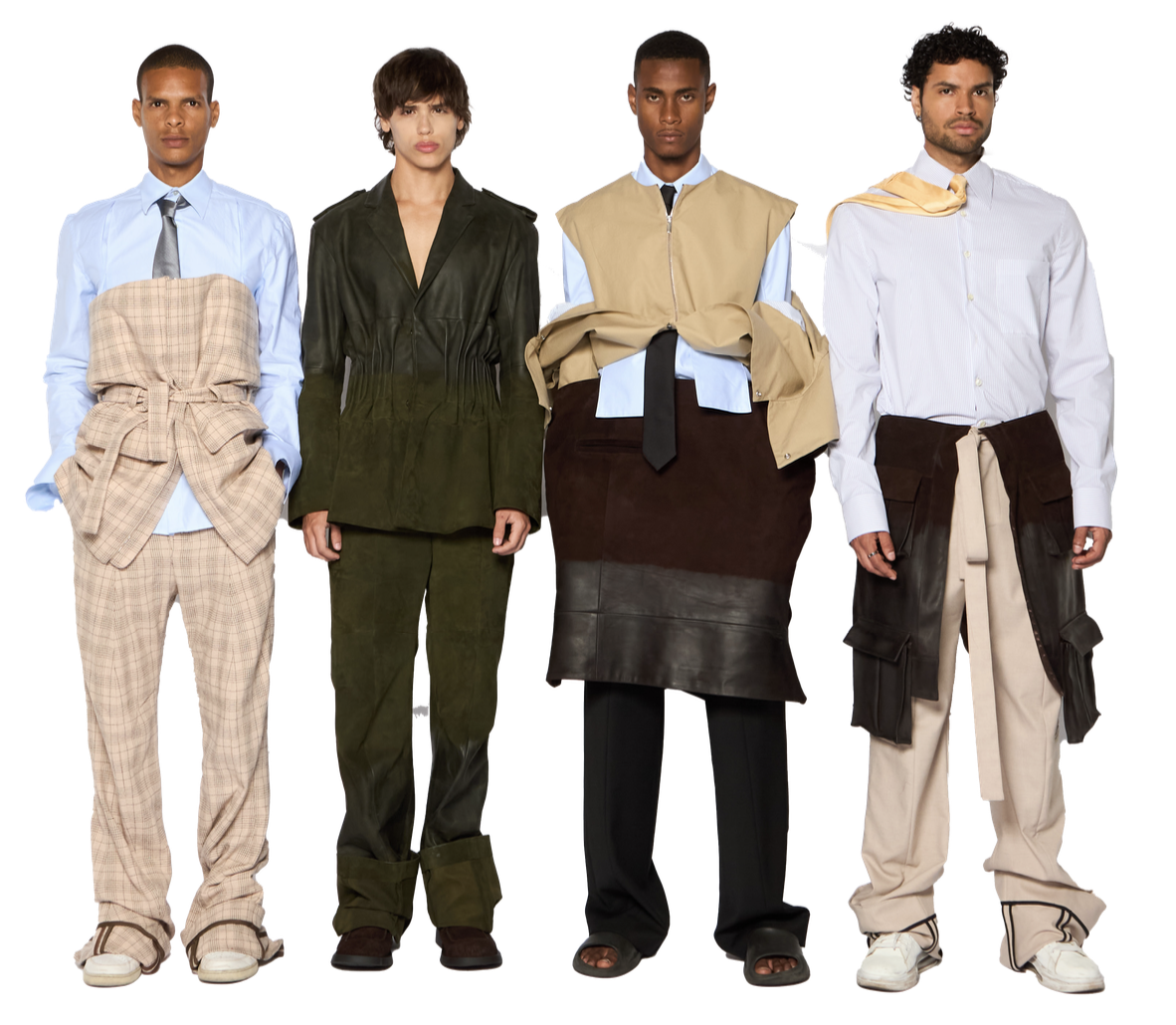
"Ribellione Legacy" by Kyunghoe Ku, presented at XC90 fashion show
Beatricia Rotaru’s A ME VEL PRO ME Graduate Collection: Theatre and Philosophy
For Beatricia Rotaru, the stage represents life itself. Her collection is aptly named “A ME VEL PRO ME,” which translates from Latin to “for me or by me.” This title serves not only as a name but as a thought-provoking philosophical question: Is our destiny truly ours to shape, or is it already predetermined?
Rotaru places introspection at the core of her designs, using the metaphor of theatre to explore self-awareness and personal choice. “The protagonist,” she notes, “must decide whether they are the scriptwriter of this play, or just another character within it.”
Her garments echo the movements of marionettes; the tensions, pulls, and distortions of fabric serve as visual representations of life’s winding paths. Sketches of roads, layered with irregular twists and turns, reinforce this metaphor. Yet the collection never loses clarity, as Rotaru insists that even distorted movement can be intentional, ultimately revealing who we are meant to become.
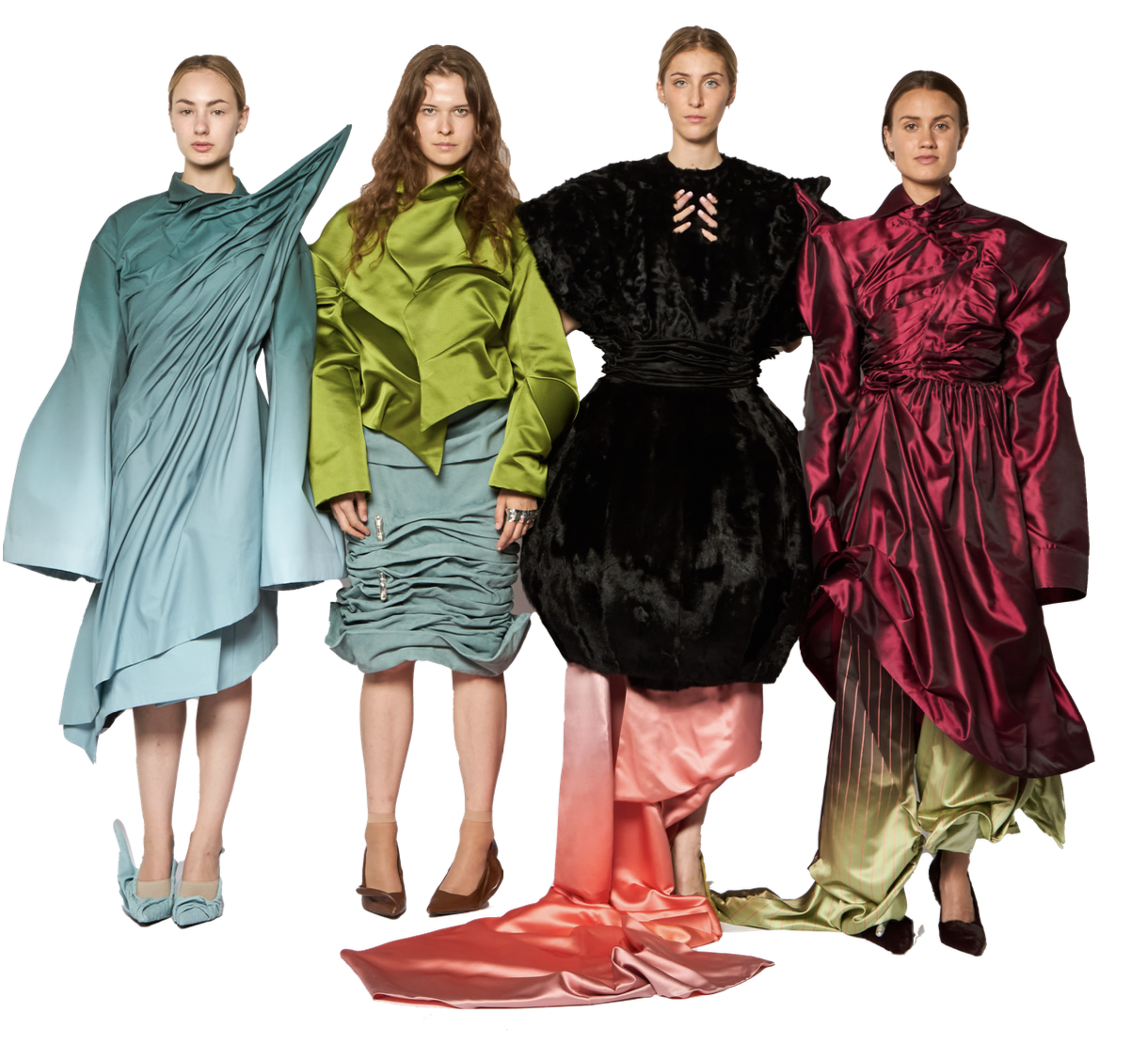
Looks from "A me vel pro me" by Beatricia Rotaru
Giorgia Sorbillo’s VADO. C’È L’ALTALENA LIBERA: Playful and Experimental Fashion Trends
What happens when Ettore Sottsass’ playful design meets the rebellious spirit of Pippi Longstocking? For emerging designer and Istituto Marangoni Milano alumna Giorgia Candida Sorbillo, this unexpected combination forms the heartbeat of her collection. She deliberately avoids linearity and instead embraces design as an emotional act, celebrating freedom of form and fostering creativity that invites interaction rather than instant comprehension.
The collection encourages touch, deconstruction, and reinvention. Fabrics such as faux fur and pony hair, as well as shoes, are reinterpreted in innovative ways. For example, fur is often left intact on garments, but in Sorbillo’s collection, it is deconstructed and fragmented, infused with a sense of rebellion. Sequins shift in shape and colour depending on how the wearer moves or interacts with them, creating garments that are mutable and playful.
Sorbillo draws inspiration from Pippi Longstocking, evident in her whimsical approach. “Who laughs more than Pippi, with her braids defying gravity?” she asks. Like Sottsass, she believes that order is merely a convention that joy can dismantle, much like a Memphis piece of furniture that may appear humorous yet embody a serious design vision.
“On the swing, you don’t go anywhere, but you see everything more clearly.” This philosophy of movement, humour, and boundless creativity resonates through every piece in the collection.
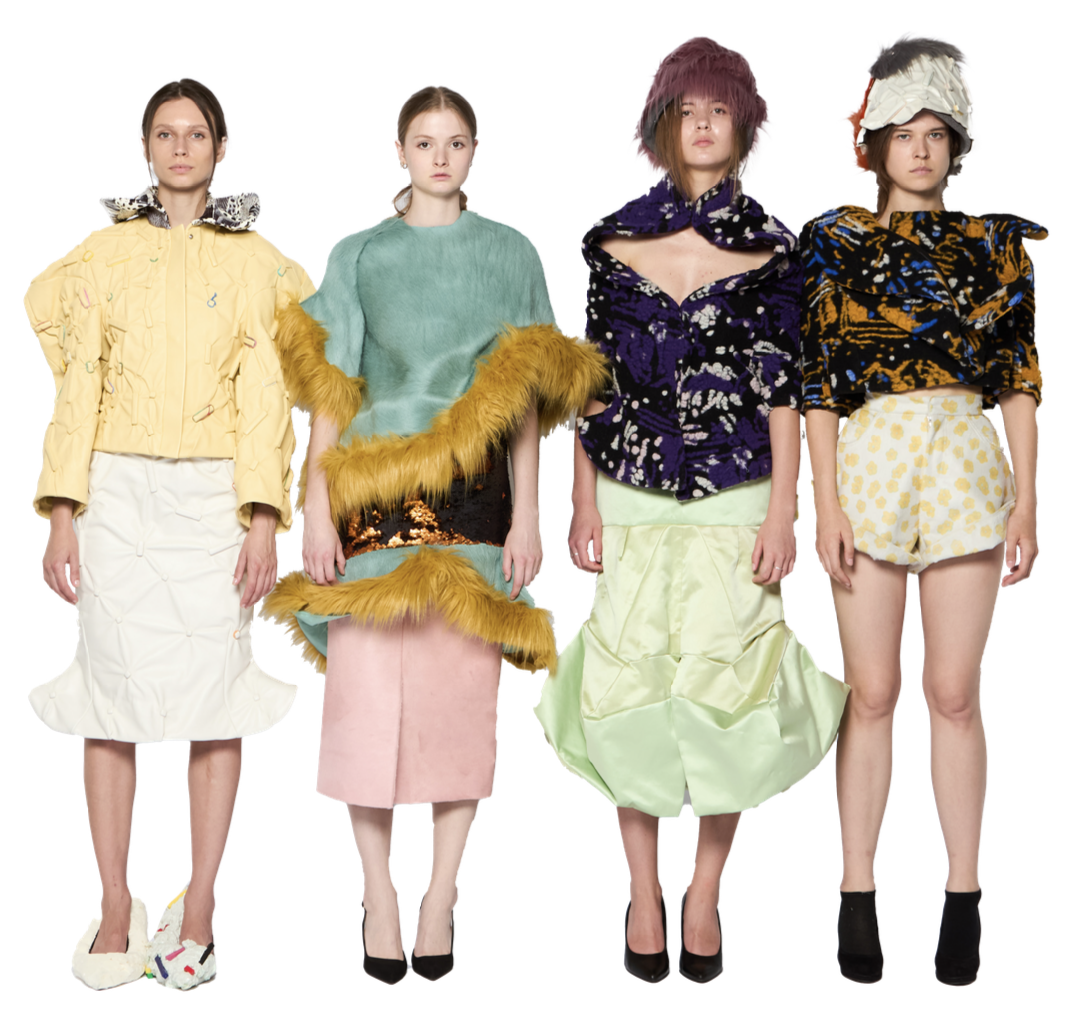
"Vado. C'è l'altalena libera" by Giorgia Sorbillo
Giuseppina Lamiranda’s ANCESTRAL RHYTHMS: Modern Fashion Inspired by Italian Traditions
For this collection, designer Giuseppina Lamiranda draws inspiration from ancient memories nestled in the hills of Lucania, her homeland. Each year, the Tricarico Carnival casts a spell of renewal, where humans and animals merge in an archaic ritual, donning masks as the Bull and the Cow to evoke transhumance—an ancestral journey marked by sounds, steps, cowbells, and silent pauses.
The masks, known as “Màshkr”, embody the essence of the earth and the rhythm of rural life. A procession of powerful, symbolic figures dances between the sacred and the profane, fusing legend and reality. From this vision, the collection comes alive like a moving herd with soft silhouettes reminiscent of rolling pastures, and strong structures echoing the mountain ridges. Lightweight, textured fabrics layer upon one another, much like strata of memory, while long ribbons float in the air, amplifying every gesture, movement, and celebration.
The emerging designer explains that her process began with prints inspired by tradition, reinterpreted for a modern context. “With this collection, I wanted to honour my roots while creating a dialogue between past and present. Fashion, for me, is not just about celebrating heritage; it’s about speaking a new, contemporary language. I hope that’s what resonates with everyone who watches the show,” she explains, presenting a collection that is both original and mesmerising.
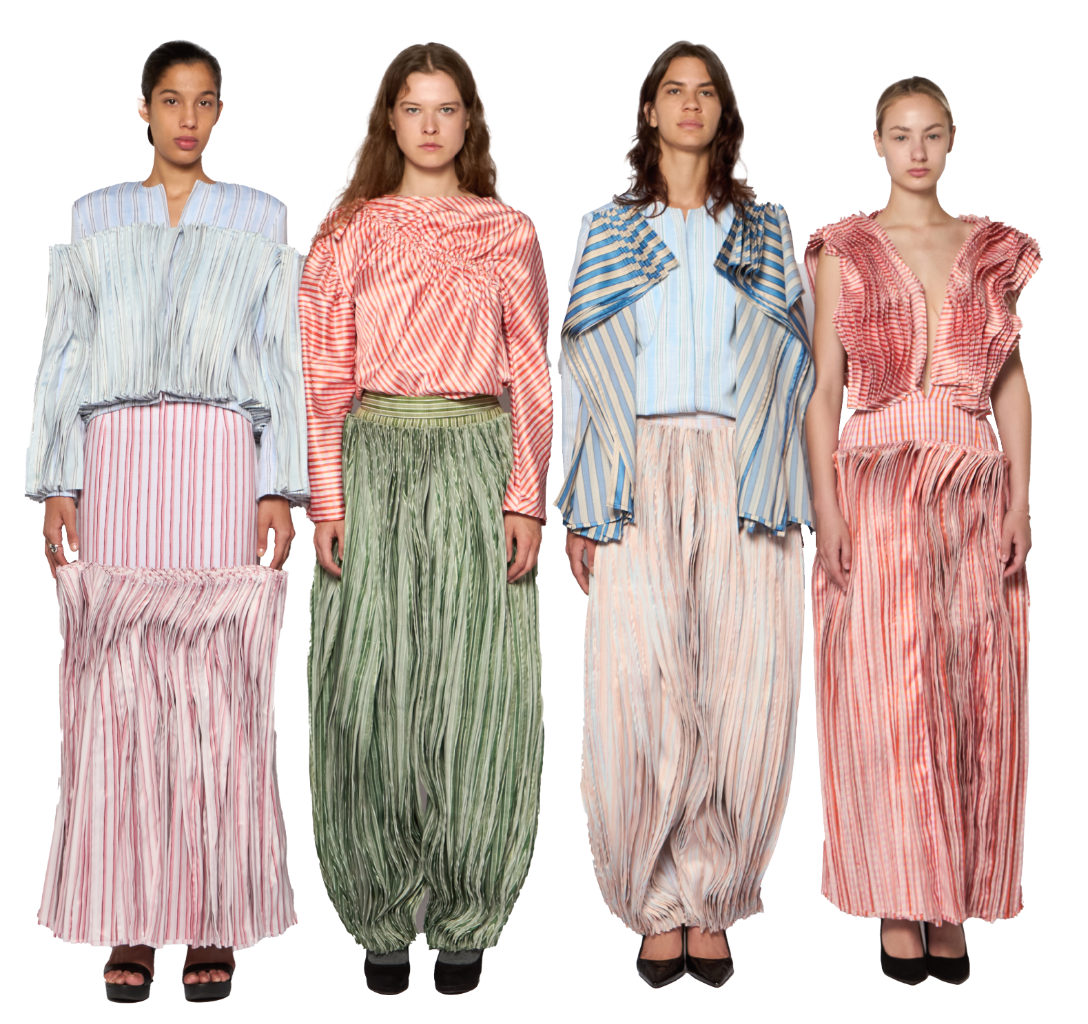
Four full looks presented at XC 90 Fashion Show from "Ancestral Rhythms" by Giuseppina Lamiranda
Jacopo Maria Arena’s DIVERSO: Gender Identity and Inclusivity in Emerging Fashion
Jacopo Maria Arena’s collection, DIVERSO, turns the spotlight on a conversation that resonates strongly with younger generations: a critical exploration of gender identity. Through fashion, the collection challenges traditional categories, questioning the very boundaries that define masculinity and femininity. Its conceptual roots lie in Plato’s Symposium, particularly the myth of the androgynous being, an entity that once embodied both human genders, thereby creating a third possibility that transcended conventional limits.
DIVERSO emerged as an act of rebellion against constant judgements—both external and internal—that often compel us to dilute our authenticity out of fear of misunderstanding or being labelled. In this way, Arena’s work goes beyond mere aesthetic experimentation; it is an invitation to reclaim and celebrate the freedom to simply be ourselves.
The visual language of the collection references the bold graphics of 1950s and 60s advertising, with a deliberate emphasis on striking, impactful colour palettes. The name DIVERSO is a statement in itself. As the Istituto Marangoni Milano alumnus explains, “In today’s world, diversity is still often misunderstood or judged. I wanted to present it exactly like this, unapologetically, without compromise.”
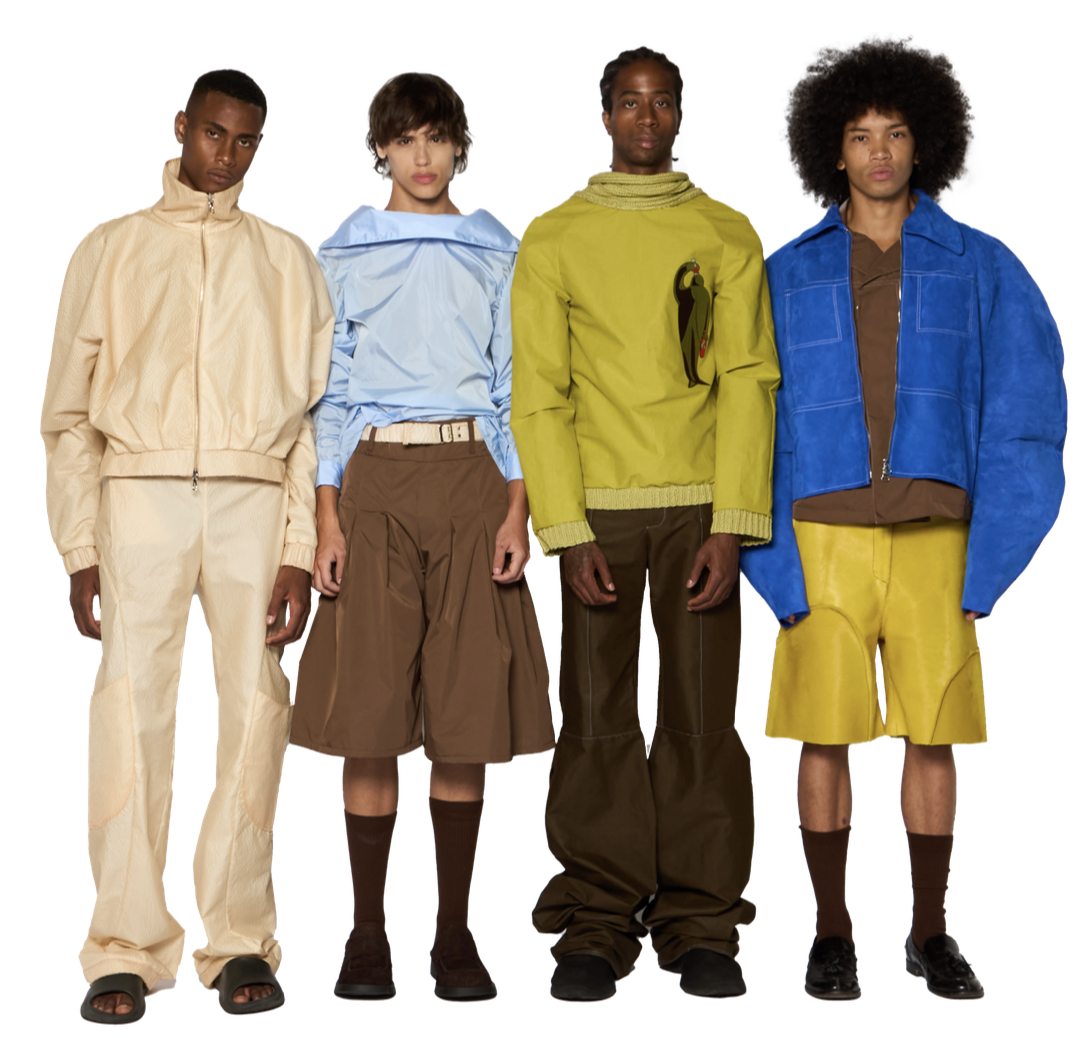
"Diverso" by Jacopo Maria Arena
Asia Pecorini’s PSICOFORME: Surreal Sculptural Designs in Contemporary Fashion
Asia Pecorini’s collection draws inspiration from the dissolution of the mind, allowing the designs to take centre stage. As she explains, “Where forms come to life and the mind drifts away.” Her graduate collection is a deliberate escape from reality, guiding the viewer through the hypnotic space of instinct and irrationality, where dreamlike and distorted realities coexist.
The designs feature exaggerated volumes and sculptural shapes, crafted from structured fabrics and rigid leathers to achieve bold, defined silhouettes that remain both elegant and refined. Pecorini’s work evokes a surreal dimension where perception is altered, and the aesthetic becomes visionary while still maintaining a minimal and clean sensibility. The collection acts as a meditation on the boundaries between reality and reverie, transforming garments into a portal for a hypnotic, otherworldly experience.
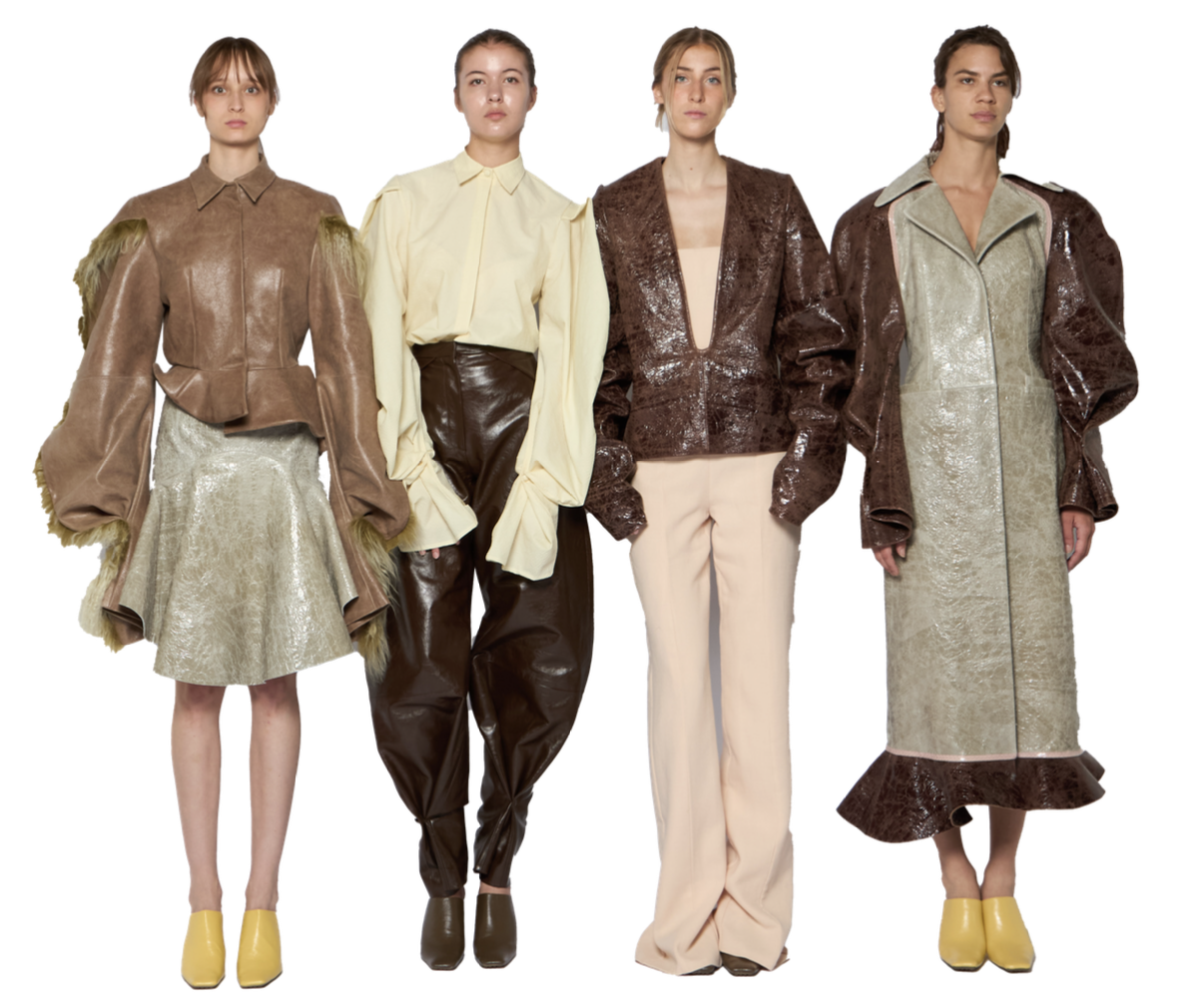
Ensembles from "Psicoforme" by Asia Pecorini
Katsiaryna Yermakova’s RESIDUE: Memory-Inspired Graduate Collection
Emerging designer Katsiaryna Yermakova presents her collection framed by a thought-provoking question: What endures when everything else fades away?
Inspired by a scene from Tarkovsky’s The Sacrifice, the collection navigates two landscapes: the elusive silence of her childhood in Belarus, which emerges almost from the subconscious, and the wind-sculpted cliffs of the Seven Sisters.
As the title suggests, this collection is a search for “residue”—something that persists through change, an inner home that survives even as everything else dissolves. It reflects a primal call back to her childhood, resonating with the echoes of rural Belarusian tradition that feel both familiar and dreamlike.
The garments draw inspiration from the history of outdoor wear, designed for protection and movement, as well as traditional costume. They weave together themes of stability and fragility, of matter and dream. Some fabrics evoke the vibrant and lively textures of coral, while others remind us of corduroy or paper—symbols of shelter that create a sense of refuge, akin to a cocoon. This comfort is particularly sought in these uncertain times.
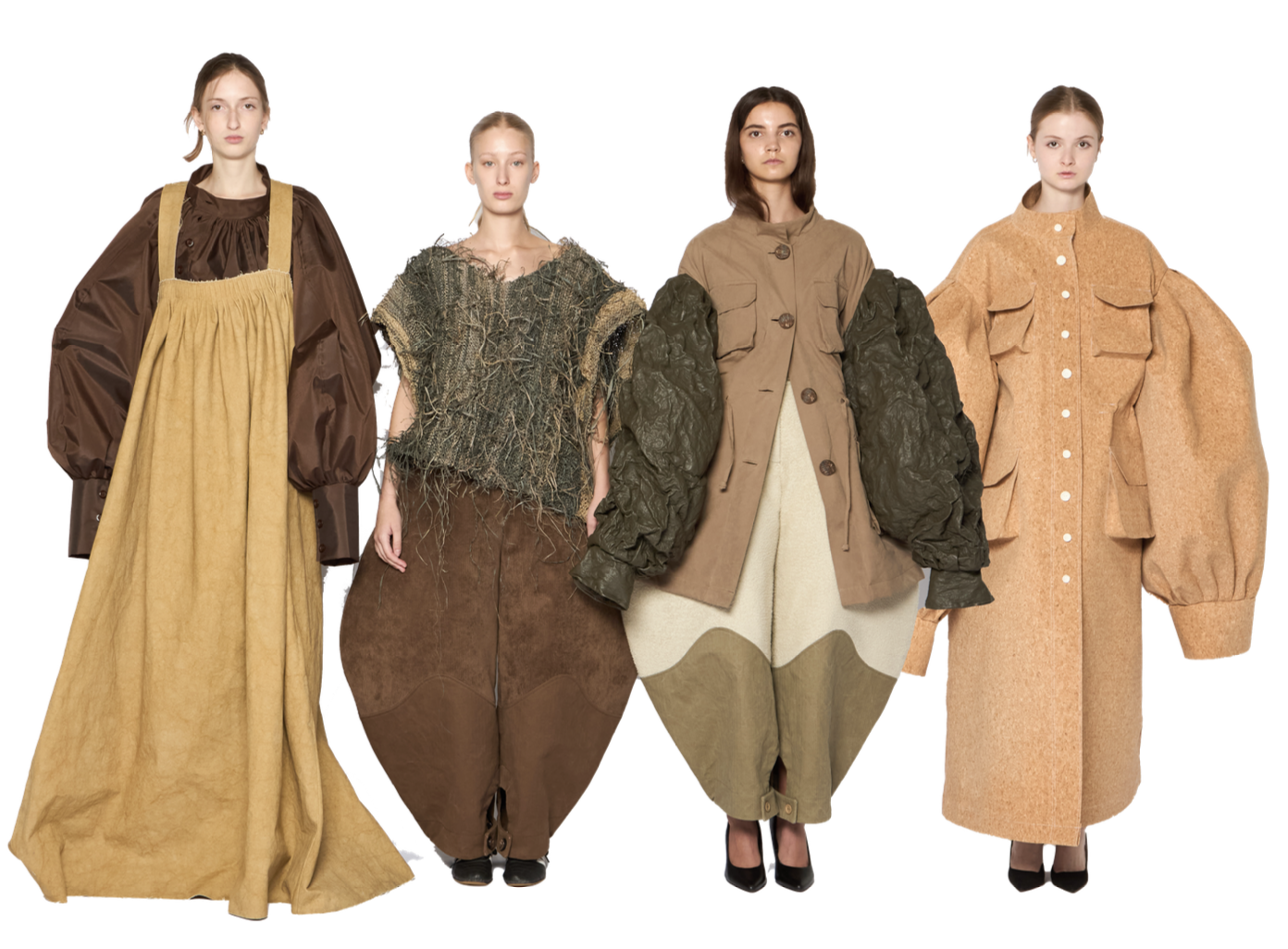
Katsiaryna Yermakova's Residue presented at XC 90 Fashion Show 2025
Marco Tulli’s OTIA LIBERRIMA: Menswear Innovation and Poetic Freedom
OTIA LIBERRIMA by Marco Tulli, an alumnus of Istituto Marangoni Milano, is a menswear collection that evokes a poetic escape for the modern man, who is often constrained by rigid social conventions and expectations. In a world dominated by structure and formality, OTIA LIBERRIMA is an invitation to reconnect with a deeper, instinctual sense of freedom.
Classic menswear staples, typically seen as symbols of discipline and decorum, are transformed into canvases that reflect the delicate touch of nature. Blush petals appear to creep into seams, embroidered flowers bloom across fabrics, and vibrant hues flow organically through each garment. These subtle yet powerful details evoke a return to our origins, awakening the wild spirit of man to harmonise with the natural world.
The collection begins with the structured, precise silhouettes of 1980s menswear, gradually overlaid with organic elements. Through embroidery, texture, and layering, each piece tells a story of rebirth and rediscovery. For instance, beneath a classic wool blazer, a lightly textured floral fabric emerges, creating an intimate dialogue between the formal and the organic.
Nature is not merely decorative here; it informs the choice of materials. A striped cotton poplin may appear traditional, yet it is synthetic, more rigid and structured, resembling a fabric that has been reshaped over time, as if influenced by nature itself.
OTIA LIBERRIMA captures the tension between order and wildness, as well as between the classical and the fragile. It represents a journey toward freedom, where humans rediscover themselves through the delicate incursions of nature.
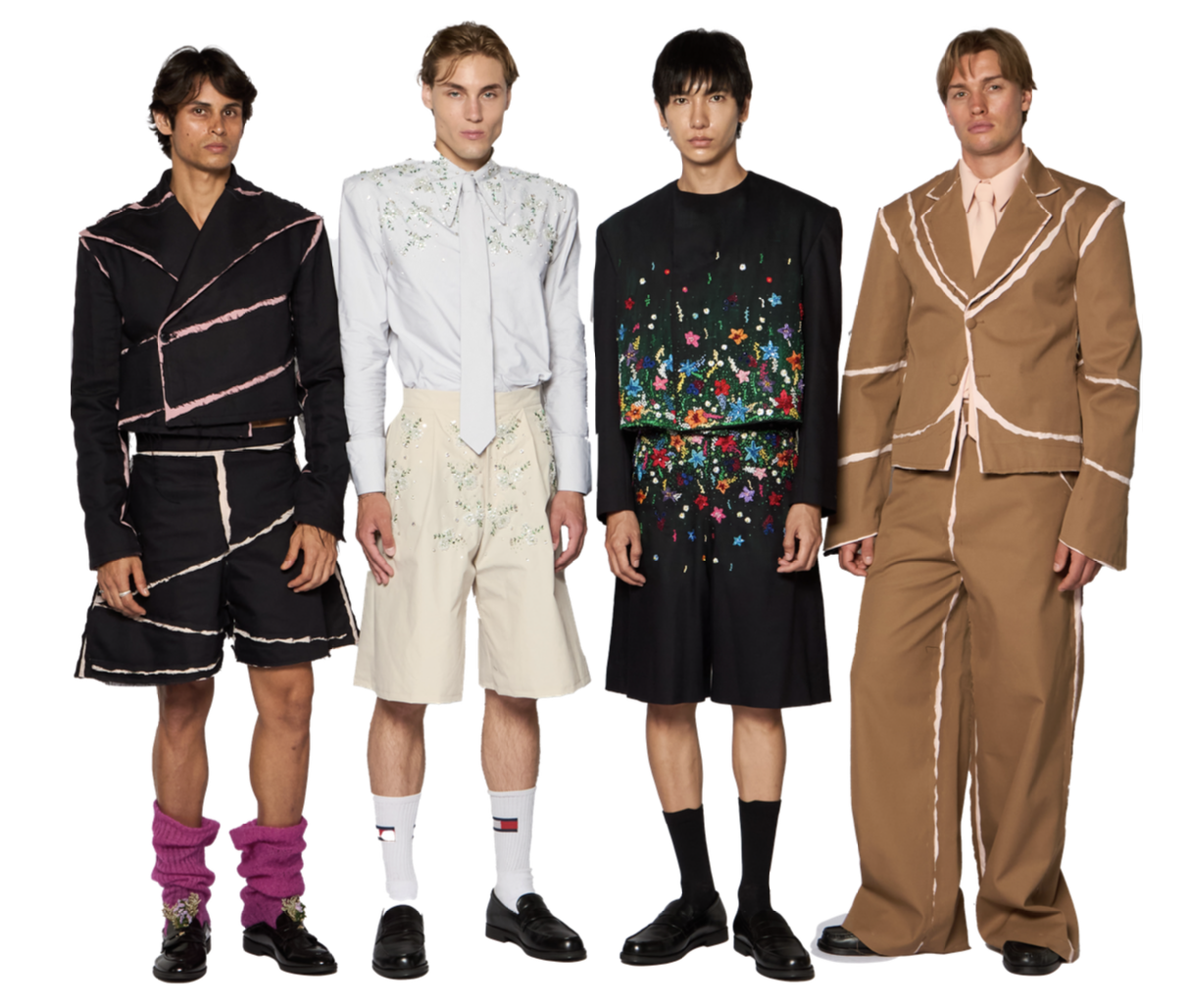
Looks by Marco Tulli, taken from "Otia Liberrima" capsule
Vittorio Tinti’s GALLERIA 67: Arte Povera Influences in Fashion Design
Vittorio Tinti’s vision is inspired by diverse creative worlds, particularly Arte Povera, which lends its name to his collection, GALLERIA 67. This title is a nod to the seminal 1967 exhibition at Galleria La Bertesca in Genoa, a pivotal moment for the movement. Just as Arte Povera challenged the concept of the finished artwork by elevating both material and idea, Tinti’s collection reflects the necessity of breaking from tradition in order to forge new visual languages.
The selection of materials is both meticulous and intentional, intertwining references to Kounellis, concrete, flowers, and leather. This interplay creates a constant tension between rejection and memory. “I like to take these materials and refine them slightly, perhaps draping a softer cloak over a raw structure, adding glints of polished metal, manipulating the material to give it a subtle sophistication,” Tinti explains.
Additionally, the collection is influenced by rock ‘n’ roll, with hints of Mick Jagger’s stage presence, lending it a more theatrical, performative edge. As he developed the pieces, the various influences began to layer and merge organically. “While I was drawing one thing, I was doing another; over time, they came together and became a single entity,” he reflects. The result is a collection that balances raw materiality with refined expression, deeply rooted in art history yet alive with contemporary energy.
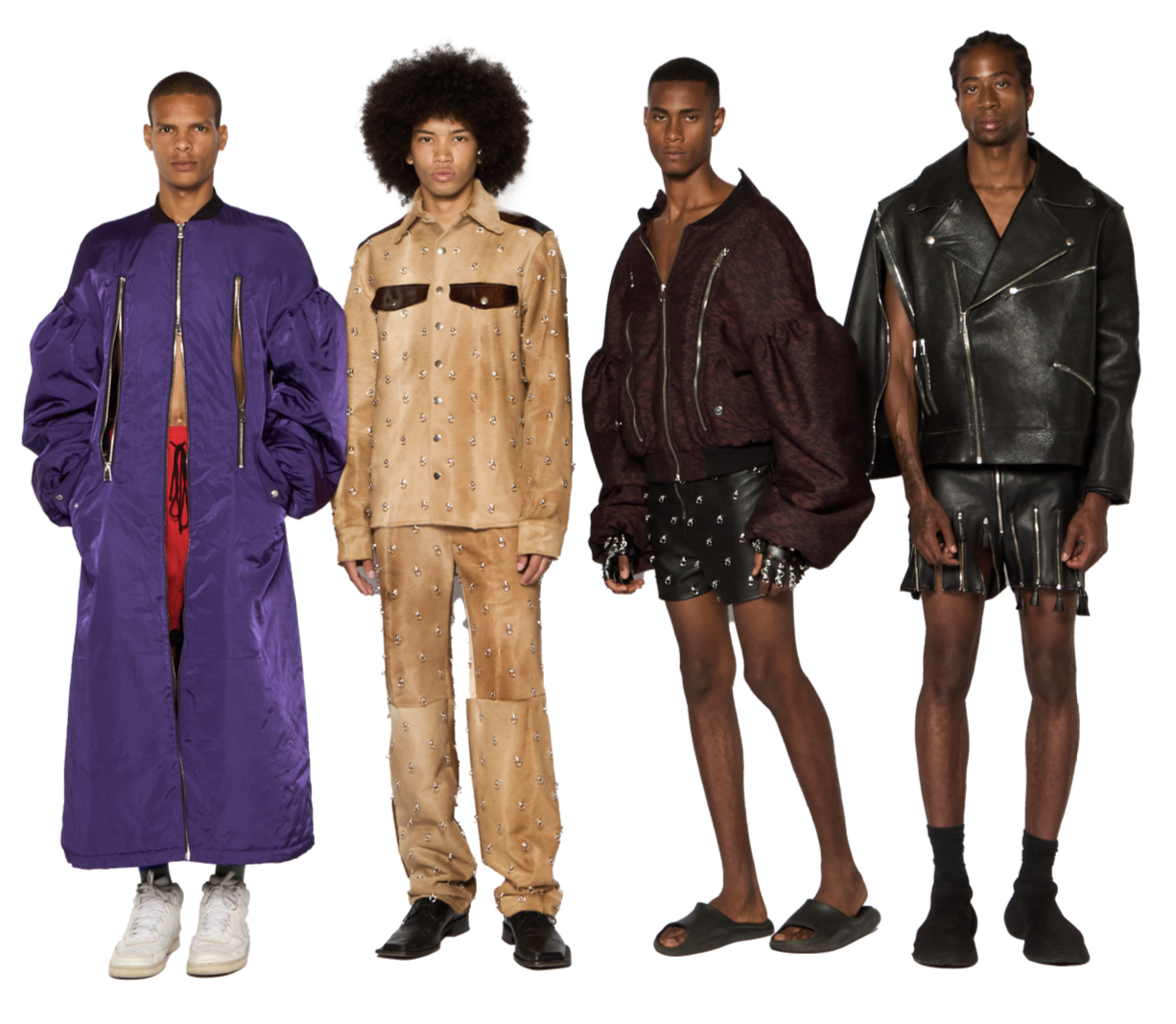
"Galleria 67" by Vittorio Tinti
Maresia Cristini’s RESTO IN SOSPESO: Fashion and Human Complexity
For her graduate collection, emerging designer Maresia Cristini begins with a question we all encounter in childhood: “Who are you?” or even “Who do you want to become?”. These questions often suggest that there is only one answer, promoting the idea of “pick one thing and do it well.” But why limit ourselves to just one identity? “When asked ‘Who are you?’ I answer with a multitude,” the Istituto Marangoni Milano alumna tells us, as she articulates the core concept of her collection. She emphasises that human beings are composed of dissonant symphonies, colliding desires, contradictory thoughts that coexist, because we are ultimately made up of many components, particularly contradictions.
“I designed the pieces of the collection with this idea in mind,” she continues, “not to dress the body according to its form, but to adapt the body to the garments themselves.” The resulting silhouettes challenge conventional designs, reflecting the complexity within us all: layered, complex, and unapologetically contradictory.
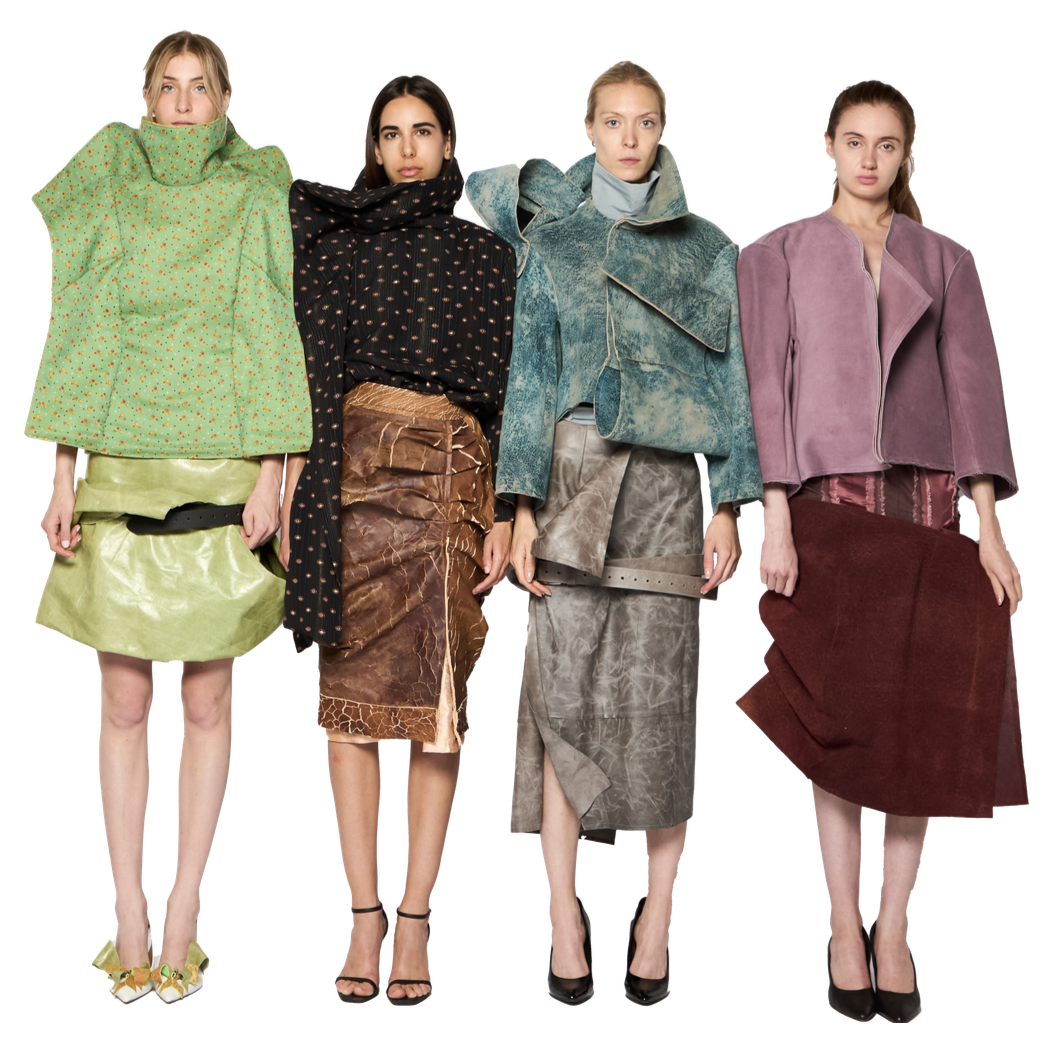
Looks from "Resto In Sospeso" by Maresia Cristini
Lucrezia Spina
Alumna & Editor, Milano



